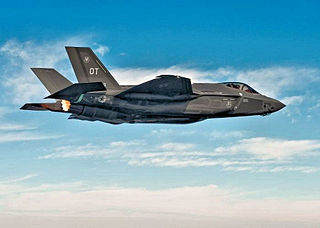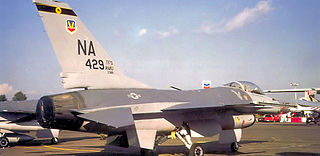
The Consolidated B-32 Dominator was an American heavy strategic bomber built for United States Army Air Forces during World War II, which had the distinction of being the last Allied aircraft to be engaged in combat during World War II. It was developed by Consolidated Aircraft in parallel with the Boeing B-29 Superfortress as a fallback design should the B-29 prove unsuccessful. The B-32 only reached units in the Pacific during mid-1945, and subsequently only saw limited combat operations against Japanese targets before the end of the war. Most of the extant orders of the B-32 were canceled shortly thereafter and only 118 B-32 airframes of all types were built.

The LTV A-7 Corsair II is an American carrier-capable subsonic light attack aircraft manufactured by Ling-Temco-Vought (LTV) to replace the Douglas A-4 Skyhawk. Its airframe design is a somewhat smaller version of the supersonic Vought F-8 Crusader. The Corsair II initially entered service with the United States Navy (USN) during the Vietnam War. It was later adopted by the United States Air Force (USAF), including the Air National Guard (ANG), to replace the Douglas A-1 Skyraider and North American F-100 Super Sabre. The aircraft was also exported to Greece in the 1970s, and to Portugal in the late 1980s. The USAF and USN retired the type in 1991, the ANG in 1993 the Portuguese Air Force in 1999 and the Hellenic Air Force in 2014.

The Northrop/McDonnell Douglas YF-23 is an American single-seat, twin-engine stealth fighter aircraft technology demonstrator designed for the United States Air Force (USAF). The design was a finalist in the USAF's Advanced Tactical Fighter (ATF) competition, battling the Lockheed YF-22 for a production contract. Two YF-23 prototypes were built, nicknamed "Black Widow II" and "Gray Ghost".

The Curtiss-Wright XF-87 Blackhawk was a prototype American all-weather jet fighter interceptor and the company's last aircraft project. Designed as a replacement for the World War II–era propeller-driven P-61 Black Widow night/interceptor aircraft, the XF-87 lost in government procurement competition to the Northrop F-89 Scorpion. The loss of the contract was fatal to the company; the Curtiss-Wright Corporation closed down its aviation division, selling its assets to North American Aviation.

The Lockheed/Boeing/General Dynamics YF-22 was an American single-seat, twin-engine fighter aircraft technology demonstrator designed for the United States Air Force (USAF). The design was a finalist in the USAF's Advanced Tactical Fighter competition, and two prototypes were built for the demonstration/validation phase of the competition. The YF-22 won the contest against the Northrop YF-23, and entered production as the Lockheed Martin F-22 Raptor. The YF-22 has similar aerodynamic layout and configuration as the F-22, but with differences in the position and design of the cockpit, tail fins and wings, and in internal structural layout.

The Pratt & Whitney TF30 is a military low-bypass turbofan engine originally designed by Pratt & Whitney for the subsonic F6D Missileer fleet defense fighter, but this project was cancelled. It was later adapted with an afterburner for supersonic designs, and in this form it was the world's first production afterburning turbofan, going on to power the F-111 and the F-14A Tomcat, as well seeing use in early versions of the A-7 Corsair II without an afterburner. First flight of the TF30 was in 1964 and production continued until 1986.
The Douglas XB-31 was the design submitted by Douglas after the request by the United States Army Air Forces for a very heavy bomber aircraft, the same request that led to the Boeing B-29 Superfortress, Lockheed XB-30, and Consolidated B-32 Dominator.

The General Dynamics F-16XL is a derivative of the F-16 Fighting Falcon, with a cranked-arrow delta wing. It was originally conceived as a technology demonstrator, later entered in the United States Air Force's (USAF) Enhanced Tactical Fighter (ETF) competition but lost to the F-15E Strike Eagle. Several years after the prototypes were shelved, they were turned over to NASA for additional aeronautical research. Both aircraft are currently stored at Edwards AFB.
The Martin XB-68 was a supersonic medium tactical bomber with a crew of two that was proposed in 1954 to the United States Air Force. The project, however, was canceled before any aircraft were built.

The Convair XB-53 was a proposed jet-powered medium bomber aircraft, designed by Convair for the United States Army Air Forces. With a radical tailless, forward-swept wing design, the aircraft appeared futuristic; however, the project was canceled before either of the two prototypes were completed.

The General Dynamics–Grumman EF-111A Raven is an electronic-warfare aircraft designed to replace the B-66 Destroyer in the United States Air Force. Its crews and maintainers often called it the "Spark-Vark", a play on the F-111's "Aardvark" nickname.

The 425th Fighter Squadron is part of the 56th Operations Group at Luke Air Force Base, Arizona. It operates the General Dynamics F-16 Fighting Falcon aircraft conducting advanced fighter training for Republic of Singapore Air Force F-16 pilots.

The 422d Test and Evaluation Squadron is a United States Air Force unit. It is assigned to the 53d Test and Evaluation Group, stationed at Nellis Air Force Base, Nevada. The squadron performs operational testing of all fighter aircraft and munitions entering and in operational use by Air Combat Command.

The General Dynamics/Grumman F-111B was a long-range carrier-based interceptor aircraft that was planned to be a follow-on to the F-4 Phantom II for the United States Navy (USN).

The 474th Tactical Fighter Wing is an inactive United States Air Force unit. Its last assignment was at Nellis Air Force Base, Nevada, where it trained combat-ready aircrews and maintained a rapid-reaction capability to execute fighter attacks against enemy forces and facilities in time of crisis. During its operational lifetime, the 474th was engaged in combat operations during the Korean and Vietnam Wars. The 474th TFW was inactivated on 30 September 1989.

The 430th Expeditionary Electronic Combat Squadron is an active United States Air Force unit. It is assigned to the 451st Expeditionary Operations Group and stationed at Kandahar Air Base, Afghanistan.
The Vought/General Dynamics Model 1600 series was a prototype fighter aircraft proposal designed for the United States Navy's Navy Air Combat Fighter (NACF) program. The Model 1600 was a navalized derivative of the General Dynamics F-16 Fighting Falcon, but lost to the Northrop/McDonnell Douglas F/A-18 Hornet.

The Stinson Model O was an American single-engined military trainer aircraft of the 1930s designed built by the Stinson Aircraft Company. Based on the Stinson SR, the Model O was designed to meet a requirement of the Honduran Air Force, forming the initial equipment of that air arm.
The Convair Model 23 was a 1950s design for an American nuclear-powered seaplane for the United States Navy. Like the Air Force's WS-125, the Model 23 never left the drawing board due to risks posed by operations of nuclear-powered aircraft.


















